At the present time there are only two pieces of artifacts of such peculiar pattern, which both were unearthed from the tombs of the Han Dynasty at the Niukouyu in Beimang Village, Xingyang City, no similar object has been unearthed in other areas. But we can find out many similar designs as “mythical creature holding fish” in the historical texts, and on the excavated belt hooks of Han and Jin periods.
The belt hooks with design of mythical creature with fish in hands have been unearthed from various places of China, such as Hebei, Shandong, Chongqing and Jiangsu, and are mostly collected in the local museums. These bronze belt hooks, skillfully crafted, were supposedly garment implements used by the man in Han dynasty.
Most of the bronze belt hooks have auspicious inscription such as “Bing wu shen gou jun gao qian”(literally the owner of the belt will get promotion with this divine hook at the time of Bingwu”), “Bing wu shen gou shou bao yu wei zhi gong hou”(literally the belt hook will get you promoted to Gong or Marquis ranks with this divine hands of hook holding a fish). Inscription begin with“Bing Wu” are commonly seen on bronze mirrors, bronze washing pots, swords, and belt hooks of Han dynasty. Mr. Pang Pu noted that “Bing wu” is corresponding to “fire” (one of the five elements of Wu Xing ), and fire can overcome metal ( another element of Wu Xing ), so the inscriptions begin with“Bing wu” is a good omen for making metal wares. Additionally, people in Han Dynasty believed that fire can overcome metal, so it can convert the misfortune into blessings. The auspicious inscription, such as “jun gao qian” and “wei zhi gong hou” on the bronzes was naturally in conformity with the design of the mythical creature with fish in hands on the belt hooks. Some scholar interpreted the pronunciation of “yu(fish)” to be identical with that of “hou(Marquis)”, so the inscription “shou bao yu(literally means holding the fish by hands)” means good wishes for the holder to get a higher official rank. With the inscription, we can find out that the pattern of the mythical creature with fish in hands is the representation of pursuing or good wishes for an official promotion or being nobility in Han period.
Fish in hands of the mythical creature was a frequently seen auspicious theme of the Han images. The inscriptions on the bronze wares with fish motif in Han period were generally auspicious expressions, such as “Yi Wang Hou”, “Da Ji Chang” and etc. The incised words “Shou Bao Bai Yu” (literally holding a white fish in hands) on the “Bing Wu” belt hook and the remained white pigment on the fish of the earthenware indicates that they were prevailing propitious talismans of white fish of the ages. In the Annals of Zhou of the Records of the Grand Historian, it is recorded that “When King Wu of Zhou crossing a river, a white fish jumped into his boat in the middle of the river, King Wu bent to take it and made a sacrifice with it. And Lun Heng (Critical Essays by Wang Chong) on Propitious Signs says: As for white fish, Chi Wu (crow, sometimes is the Sun), trifles, and etc, are signs for minor peace. With the aforementioned reference from the historical texts, we know that the white fish was viewed as a symbol of royal conferring, peace and luckiness.
Altogether four birds around the mythical creature (Fig. 1) whose profiles resemble the phoenix recorded in historical documents. Being the symbol of good luck and happiness, phoenix was frequently shown in pictorial bricks, murals, and various objects in Han dynasty for good fortune. On the necks of the two birds, were tied purple ribbons, which were usually used to thread the official seal in Han era, one ribbon for one seal. The Hou Han Shu(History of the Later Han) On Travel and Dress detailed the color, length, texture of the ribbons which were distinct from different ranks: the emperor bears the yellow; the princes wear the red; the kings and aristocrats of the vassal states, the green; Gong, Marquis, and Generals have the purple ones. Thus the purple ribbons on the birds’ neck of this earthenware imply acquiring Gong or Marquis-class high ranks and high salary. And great many images of phoenix or rose finches adorned with ribbons carved on the pictorial bricks of Han dynasty have been found, as shown in the following rubbings or drawings from the Han tomb at Baizhuang village, Linyi, Shandong (Fig.2), Han tomb at Hanjiaqu, Yishui, Shandong (Fig.3), which indicate that phoenix was a auspicious mythical bird that could bring wealth and ranks in Han period.
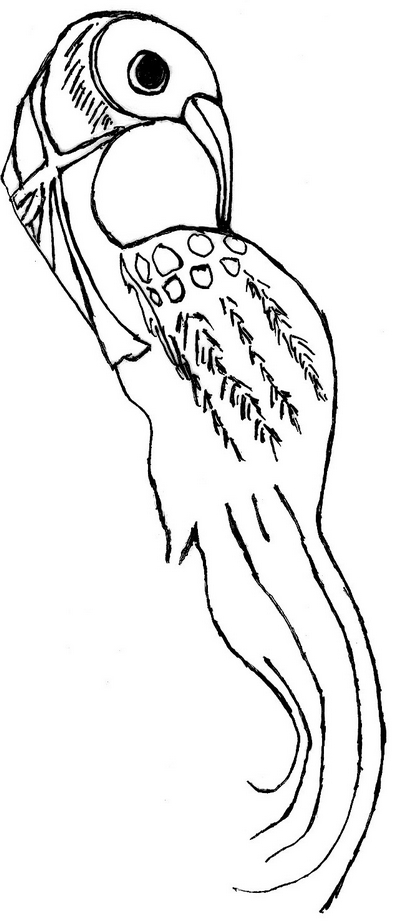
|
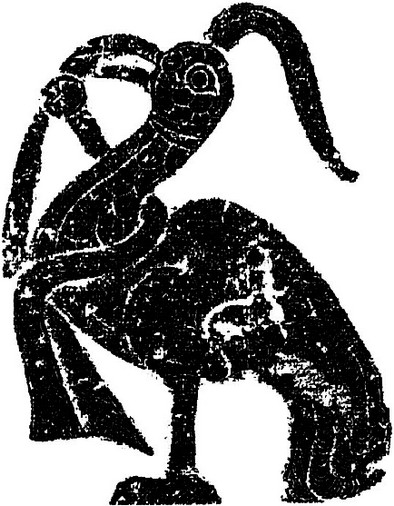
|
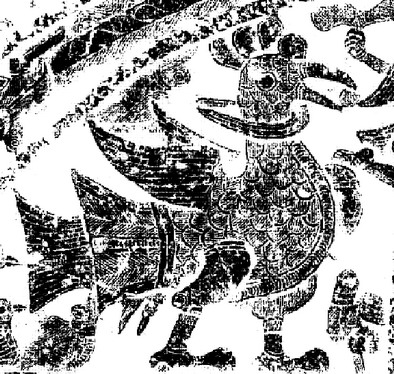
|
Fig.1 Drawing of the phoenix wearing ribbon housed by Henan Museum
Fig.2 Rubbing of the phoenix-like bird with ribbon in beak from the Han tomb at Baizhuang village, Linyi, Shandong
Fig.3 Rubbing of the phoenix-like bird adorned with ribbon from the Han tomb at Hanjiaqu, Yishui county, Shandong
By interpreting the patterns of the mythical creature holding a fish, and the phoenix adorned with ribbon, the meaning implied by the mythical creature holding a fish of Han dynasty is for seeking being granted official titles, as well as a embodiment of the culture of auspicious signs prevailed in Han society.
1. Pottery Pedestal of Mythical Creature Embracing a Fish of Han dynasty
This artifact, dated back to Western Han period, is also excavated from the tombs at Niukouyu, Beimang township, Xingyang, Henan province, is housed by Henan Museum. Being a grey pottery with polychrome painting, made by mean of molding and kneading, it is 26cm high in total, and is similar with the other introduced this paper in appearance, profile, but its posture is holding the fish to mouth for feeding, and it was adorned with distorted cloud pattern, without the four birds and the ribbons around them.
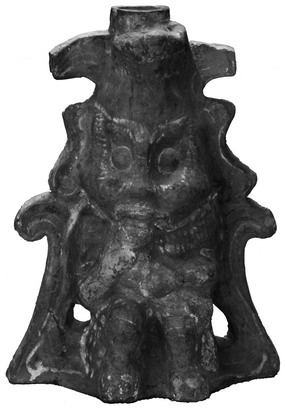
2. Belt hooks with pattern of mythical creature holding a fish
The Belt hooks with pattern of mythical creature holding a fish known are mainly made of bronze, dated back to the period from Western Han to early Western Jin dynasty. In recent yeas, bronze belt hooks with such decorations have been excavated from the Eastern Han tombs at Lizi city of Shandong, Beizhuang village, Mancheng city of Hebei(Fig.4), the Western Jin masonry tombs at Jiuxianping, Yunyang county of Chongqing(Fig.5), and Xigang, Nanjing city of Jiangsu(Fig.6), as well as Cao Xiu’s tomb at Luoyang. This kind of objects are supposed to be practical utensils, and the decorative articles used by the deceased before death.
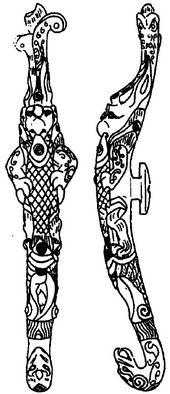
|

|

|
Fig.4. rubbings of the bronze belt hook in the Eastern Han tomb at Beizhuang village, Mancheng, Hebei province.
Fig.5. rubbings of the bronze belt hook from Jiuxianping, Yunyang, Chongqing city.
Fig.6. rubbings of the bronze belt hook from the masonry tomb of Western Jin dynasty at Xigang, Nanjing, Jiangsu province
Mythical creature holding a fish is a thematic image on earthenware pedestals and belt hooks; the mythical creature was highlighted in the form of an integration of a man and a bird. Though the overall designs on the pottery pedestals and the belt hooks are much alike, there is some discrepancy: the mouth of the mythical creature on the belt hook was molded as the protruding beak of a bird, yet on pottery it was not; the creature on the belt hook has pricked up long ears, yet no long ears on pottery ware. On belt hooks, the creature wears a high feather-like headdress, on pottery ware it is garlic-shaped; and wing-shaped articles were molded on the shoulder of the mythical creature of the belt hook, no similar items were found on that of the pottery ware. The mythical creature had a suit on the pottery, but its four limbs were adorned with cloud pattern and curved lines on belt hook except for the wing-shaped ornaments on the shoulders. The posture of the mythical creature on the belt hooks is holding a fish to its mouth, while on the pottery ware, it holding the fish to its breast with mouth grinning broadly, but on the other piece it has the same posture as on the belt hook.
The features of the mythical creature being largely identical with minor difference indicate that there should had a stylized modeling in Han period: being a figurine, seated, with bulging eyes and a high-bridge nose, a headdress, bird claws, and holding a fish, nevertheless, the characteristics of the mythical creature tended to have some variations due to different artisans, regions, and ages regardless of the typical model.
A great many images of deities and spirits of the Han beliefs have been found on the known Han murals and pictorial bricks, most of them were in the shape of animal, or combination of animal and human being. It is believed by some scholars that they were the immortals of the place of Kunwu described in a Chinese Classic text Shan Hai Jing (literally "Canon of Mountains and Seas")•Classic of Great Wilderness: South; whereas, but others viewed them as another creature illustrated in this book called Huantou, i.e. the legendary weird mankind as having a “humanoid face, beak of the bird, winged, feed on the fish in the sea”. What’s your opinion?
Your answer please, if you have any questions or answer, please fell free to send us email, we are waiting for your answers and participation, and your comments, answers and suggestions will be highly appreciated. We will select and publicize the most appropriate answers and comments some time in the future.
Weekly Selection Email: meizhouyipin@chnmus.net
1. The auspicious images in the Han designs
The Chinese propitious selection derived from the primitive society when people believed that some certain animals, plants, persons, implements, and etc., could bring fortune, good luck, and avert the evils. The main cultural elements of the propitious selections were pursuing for good fortune, averting the evils, acquiring happiness.
After the mid-Western Han, the rulers labeled the legitimacy of their ruling and vindicated the imperial power with the doctrine of Interaction between Heaven and Mankind, as well as the divination of mysticism. Additionally, various ghost and deity beliefs and immortals thoughts prevailed the civil society, thus the ordinary people paid more attention to the worldly needs, hoping everything in life to be propitious. A great quantity of Qin and Han bamboo slips excavated indicated that in daily life, people of the times would select propitious dates, averted evils and various taboos in the case of changing of residence, construction, sacrificing, funeral, wedding, and so on. The pattern of the mythical creature holding a fish was a theme of pursuing for being aristocrat and getting a promotion in Han dynasty.
2. Fish and Luckiness
The motif of fish appeared quite early, as early as in the Neolithic Ages, a great amount of fish motifs and variations could be found on the colored pottery wares, lots of scholars believed that they were greatly influenced by the totem awareness, reproductive worship, praying for a good fishing harvest, and the fish motif of Han period had rich connotations, which could be used as talisman, the oracle connecting the Heaven and the Earth, life and death, as well as the mutual transformation of Yin and Yang. Some auspicious inscriptions such as “Rich and Honor”, “Propitious for children” were frequently being found in the fish motifs on the Han pictorial bricks. The culturally propitious meanings of fish were expanded and developed during Han dynasty.
3. Tomb Guardian Animals and Figurine
The excavation of the pottery wares with pattern of mythical creature holding a fish caused much speculation among the scholars, some regarded them as tomb guardians. The tomb guardian animal models in ancient China were named Mingqi, the burial objects which were interred in the tombs for against evils, protecting the spirits of the deceased, and ushering them to heaven. Largely, the tomb guardian models excavated from the tombs of the whole Han periods resembled the animals, such as tiger, horse, and etc. and had a ferocious appearance, by showing their teeth, glaring eyes, in crawling or walking position. Also, there were other types of tomb guardian figurines that were similar with mankind, which were seated and naked, with antelope horns; some holding a sharp axe in one hand, a snake in the other, with eyes open wide and tongue protruding. Obviously, in term of physical characteristics, not only the tomb guardian animals but also the figurines were entirely different with the statuette in the form of mythical creature holding a fish.
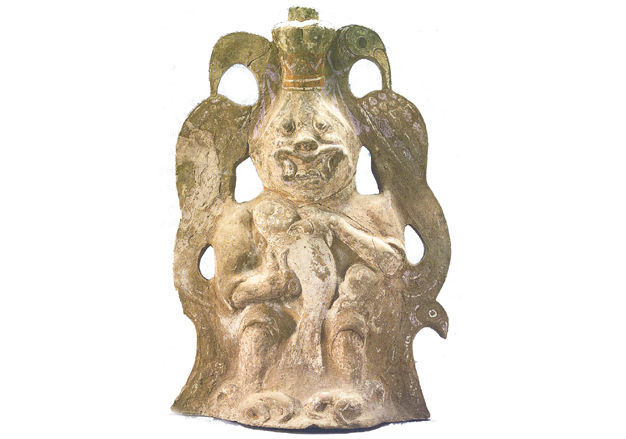
Title: Earthenware Pedestal with Mythical Creature Grasping a Fish
Category: Earthenware
Measurements: 45 cm in overall height
Provenance: unearthed from the tombs of the Han Dynasty at the Niukouyu in Beimang Village, Xingyang City, Henan Province.
Owner: now preserved in Henan Museum.

Wu Wei, born in 1974. Phd. of archaeology, vice director of the Research Dept. Associate Researcher. Chief editor of Cultural Relics of Central Plains Journal. Research on the archaeology of the Warring States, Qin and Han dynasties.